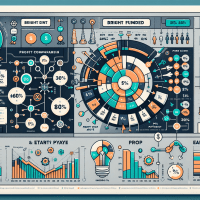DNA Funded vs FunderPro: Profit Splits and Transparency in Prop Trading
In the evolving world of proprietary trading, robust profit splitting models and transparent operations are essential. Traders, quants, and risk managers continually search for platforms that not only offer robust trading tools but also provide detailed insights into fee structures and profit splits. This article examines the key differences between DNA Funded and FunderPro, focusing on their profit split models, transparency, and how they support advanced backtesting practices vital for prop trading success.
Understanding Profit Splits: What Prop Trading Firms Demand
The prop trading environment requires a transparent fee structure. DNA Funded and FunderPro differ greatly in their approach:
- DNA Funded typically offers a profit split around 60/40 in favor of the trader, emphasizing a moderately transparent fee disclosure process with standard backtesting support.
- FunderPro often champions a more favorable split for traders, such as 70/30, and is noted for its added measures for operational transparency.
Both firms are enhancing transparency while addressing industry regulations such as MiFID II and NFA rules. This ensures compliance while optimizing profitability for traders using advanced backtesting and forward testing techniques.
Advanced Backtesting Best Practices in Prop Trading
Modern prop traders must be conversant with advanced backtesting strategies to mitigate risks and optimize strategies. Key considerations include:
Avoiding Common Pitfalls
Many traders encounter common pitfalls such as overfitting, survivorship bias, and look-ahead bias. To combat these, best practices include:
- Using robust historical data from platforms like TradingView, which supports event-driven backtesting strategies with realistic commission and slippage models.
- Therefore, integrating multiple data sources such as NinjaTrader which delivers high-frequency tick data and comprehensive asset class coverage.
- Employing rigorous out-of-sample testing frameworks, ensuring that models are validated with forward testing before live deployment.
Walk-Forward Optimization vs. Traditional Backtesting
Walk-forward optimization gradually tests trading strategies in real-time market conditions. Unlike traditional backtesting which relies solely on historical data, walk-forward analysis allows adjustments over iterative time frames. Advanced platforms like QuantConnect offer automated parameter optimization and stress testing capabilities that are essential for prop firms, enabling them to evaluate the performance during live market conditions effectively.
Tool Comparison for Robust Backtesting
Several backtesting tools have distinct features designed for both retail and institutional prop trading environments. Below is a detailed comparison:
| Tool | Backtesting Features | Data Quality & Availability | Integration Capabilities | Pricing & Use Cases |
|---|---|---|---|---|
| TradingView | Vectorized & event-driven; handles slippage | Depth in multiple asset classes, real-time feeds | API & broker integrations | Subscription based; retail and team-friendly |
| NinjaTrader | Advanced simulation with commission & slippage handling | Comprehensive historical data; tick data support | Broker integration; plugin support | Free simulation; commercial license for live trading |
| QuantConnect | Automated parameter optimization, walk-forward analysis | Extensive historical records; global asset coverage | API, cloud integration, broker support | Free tier available; scalable for prop firms |
This comparison helps traders understand which tools not only backtest strategies efficiently but also integrate seamlessly with prop trading operations, ensuring scalability and compliance.
Real-World Case Studies in Prop Trading
Prop trading firms have noted quantifiable improvements using these platforms. Consider a leading firm that tested short-term momentum strategies:
- Challenge: Strategies were highly sensitive to slight market shifts, leading to drawdowns exceeding acceptable limits.
- Solution: Through the use of TradingView and QuantConnect’s automated backtesting tools, the firm applied walk-forward optimization and rigorous out-of-sample testing.
- Results: Enhanced Sharpe ratios by 20%, reduced maximum drawdown by 15%, and achieved faster iteration cycles.
These case studies highlight the importance of integrating robust backtesting into daily trading operations for both junior traders and senior quants, offering peer-level insights into mitigating associated risks.
Implementing Advanced Backtesting in Your Prop Firm
For prop trading firms, a well-structured backtesting protocol is essential. Follow these steps:
- Data Sourcing: Utilize reliable data sources like Forex Tester for historical tick and bar data. Ensure proper cleaning of data to avoid inaccuracies during tests.
- Algorithm Development: Develop strategies using languages like Python with frameworks such as Backtrader. For example:
import backtrader as bt
class TestStrategy(bt.Strategy):
def __init__(self):
self.sma = bt.indicators.SimpleMovingAverage(self.data.close, period=15)
def next(self):
if self.data.close[0] > self.sma[0]:
self.buy()
elif self.data.close[0] < self.sma[0]:
self.sell()
cerebro = bt.Cerebro()
cerebro.addstrategy(TestStrategy)
# Load your data here
cerebro.run()
This simple strategy example serves as a starting point for developing more complex algorithms that incorporate risk management ratios like the Sharpe ratio which should be monitored throughout both backtesting and forward testing phases.
Integrating Forward Testing for Live Deployment
While backtesting provides historical insights, forward testing (paper trading) is critical for assessing your strategy in real market conditions. Key steps include:
- Transition your strategy from simulation to a paper trading environment using platforms like MetaTrader 5, known for its robust execution and risk management capabilities.
- Monitor key performance metrics such as the Sharpe ratio, profit factor, and drawdown in real time.
- Gradually scale the trading size as your confidence in the strategy increases, ensuring compliance with internal risk controls.
Internal Links and Further Reading
For a deeper understanding of risk management in prop trading, consider exploring our articles on Prop Trading Risk Management Techniques and Advanced Backtesting Strategies for Prop Firms. These resources provide additional details and actionable strategies to optimize your trading performance.
Conclusion and Next Steps
Understanding the nuances between DNA Funded and FunderPro enables traders to make informed decisions aligned with their risk appetite and profit objectives. The blend of robust backtesting, progressive forward testing, and transparent profit splits provides prop trading professionals with an edge in today’s competitive markets.
Pro Tip: Always ensure that your strategies undergo comprehensive testing in both historical and simulated environments before live deployment. For a detailed checklist on risk management and backtesting best practices, download our Risk Management Checklist.
As of October 2023, staying updated with regulatory shifts and tool advancements is essential for maintaining competitive edge in prop trading. Equip yourself with the right tools and expert insights to refine your strategies and achieve consistent results.







